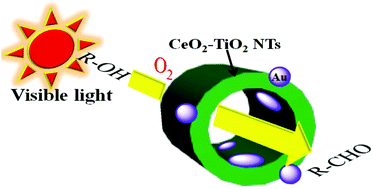Highly efficient visible-light-driven photoelectro-catalytic selective aerobic oxidation of biomass alcohols to aldehydes†
Abstract
A green and highly efficient visible-light-driven synergistic photoelectrochemical (PEC) catalysis system was systematically demonstrated for selective oxidation of biomass alcohols to the corresponding aldehydes in an O2 atmosphere under the mild conditions by employing the Au/CeO2–TiO2 NTs as photocathodes. Results showed that the conversion of benzyl alcohols was as high as 98% and the selectivity of benzaldehyde was >99% at the bias potential of −0.8 V under the visible light irradiation for 8 h. The superior performance could be attributed to the synergistic PEC process combining both the advantages of photocatalytic and electrocatalytic activity. Furthermore, the research elucidated that the PEC activity and the conversion rate of benzyl alcohol could be effectively promoted by adjusting the potential. Interestingly, the incorporation of CeO2 nanoparticles (NPs) into the inner wall of TiO2 NTs can remarkably enhance the selectivity of the PEC oxidation reaction towards a specific direction. Additionally, the rationally designed and fabricated Au/CeO2–TiO2 NT photocathode was in favour of separating electrons and holes. A probable mechanism for the PEC selective aerobic oxidation process was proposed and discussed.


 Please wait while we load your content...
Please wait while we load your content...